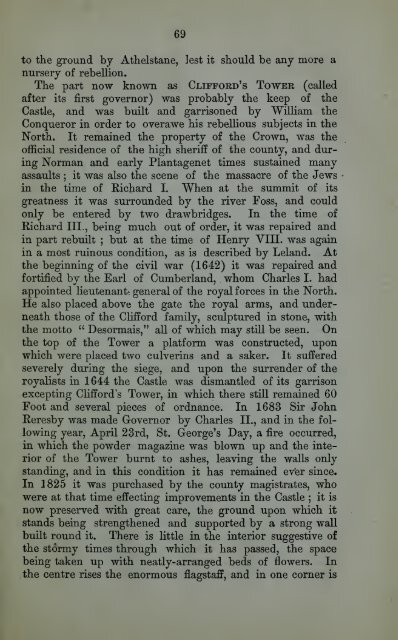practicalguideto00unse_0
Create successful ePaper yourself
Turn your PDF publications into a flip-book with our unique Google optimized e-Paper software.
69<br />
to tlie ground by Athelstane, lest it should be any more a<br />
nursery of rebellion.<br />
The part now known as Clifford's Tower (called<br />
after its first governor) was probably the keep of the<br />
Castle, and was built and garrisoned by William the<br />
Conqueror in order to overawe his rebellious subjects in the<br />
North. It remained the property of the Crown, was the<br />
official residence of the high sheriff of the county, and during<br />
Norman and early Plantagenet times sustained many<br />
assaults ;<br />
it was also the scene of the massacre of the Jews<br />
in the time of Richard I. "When at the summit of its<br />
greatness it was surrounded by the river Foss, and could<br />
only be entered by two drawbridges. In the time of<br />
Eichard III., being much out of order, it was repaired and<br />
in part rebuilt ; but at the time of Henry VIII. was again<br />
in a most ruinous condition, as is described by Leland. At<br />
the beginning of the civil war (1642) it was repaired and<br />
fortified by the Earl of Cumberland, whom Charles I. had<br />
appointed lieutenant- general of the royal forces in the North.<br />
He also placed above the gate the royal arms, and underneath<br />
those of the Clifford family, sculptured in stone, with<br />
the motto Desormais," all of which may still be seen. On<br />
the top of the Tower a platform was constructed, upon<br />
which were placed two culverins and a saker. It suffered<br />
severely during the siege, and upon the surrender of the<br />
royalists in 1644 the Castle was dismantled of its garrison<br />
excepting Clifford's Tower, in which there still remained 60<br />
Foot and several pieces of ordnance. In 1683 Sir John<br />
Eeresby was made Governor by Charles II., and in the following<br />
year, April 23rd, St. George's Day, a fire occurred,<br />
in which the powder magazine was blown up and the interior<br />
of the Tower burnt to ashes, leaving the walls only<br />
standing, and in this condition it has remained ever since.<br />
In 1825 it was purchased by the county magistrates, who<br />
were at that time effecting improvements in the Castle ;<br />
it is<br />
now preserved with great care, the ground upon which it<br />
stands being strengthened and supported by a strong wall<br />
built round it. There is little in the interior suggestive of<br />
the stormy times through which it has passed, the space<br />
being taken up with neatly-arranged beds of flowers. In<br />
the centre rises the enormous flagstaff, and in one corner is















